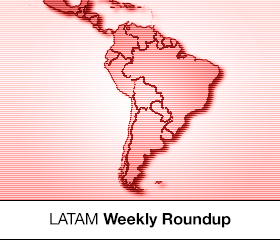What Do Ad Techs Expect For 2016 in Brazil and Latin America?
by on 29th Dec 2015 in News


In 2015’s last LATAM RoundUp we bring what some of the leaders of the ad tech scenario in Brazil and Latin America are expecting next year. We heard them about their main achievements in 2015 and what they forecast as the main trends in the market. Viewability, video and mobile are consensus, but unconventional topics such as ad blockers and DMPs were also mentioned.
Patrizio Zanatta, general manager, The Rubicon Project Latin America
 “Next year will be the year of programmatic in terms of demand in Brazil and this will require investments by agencies — both in understanding the model as well as in human resources. This will also generate more independent trading desks in Brazil, giving the size of these opportunities.
“Next year will be the year of programmatic in terms of demand in Brazil and this will require investments by agencies — both in understanding the model as well as in human resources. This will also generate more independent trading desks in Brazil, giving the size of these opportunities.
I see some challenges too, such as ad blockers. To overcome them, native formats — which cannot be blocked by them — emerge as key adopt, specially in mobile and for publishers in general.
Video keep being one of the main drivers for Rubicon in the country and we’re also putting our cards in the mobile increase. Programmatic guaranteed will be one of the main trends too, something that has been already requested by agencies in Latin America"
Marcelo Sant’Iago, country manager, MediaMath Brazil
 “The local market is still valuing price over the platform’s quality and services. There is a unique characteristic of the Brazilian market: companies want to do all, aiming for more revenues. It will be hard for the market to grow in a scalable way if each player doesn’t get clearly which are their spaces and their technical capabilities as a differential.
“The local market is still valuing price over the platform’s quality and services. There is a unique characteristic of the Brazilian market: companies want to do all, aiming for more revenues. It will be hard for the market to grow in a scalable way if each player doesn’t get clearly which are their spaces and their technical capabilities as a differential.
We expect in 2016 that CENP keeps regulating the market. Transparency, viewability and ad blockers will remain dominating the talks. Video will keep increasing, as well as mobile campaigns. Another major point is the convergence between ad tech and mar tech, which has been happening overseas for a while and will finally get here.
First party data will gain importance and several agencies and advertisers have been working in their own DMPs. Consequently, companies which have been working as DSPs only should be replaced by integrated platforms. Lastly, currency rates are in favour of acquisitions, so we will see the market consolidating itself in this matter for sure"
Luciana Burger, managing director, comScore Brazil
 “Brazil had an important growth in programmatic media in 2015, with new players and an increased volume of transactions; however, still far from reaching its potential. We still have a lot to evolve, but 2015 was fundamental to spread the understanding around the market and the beginning of a ‘Brazilian model’ towards programmatic media. In developed countries, the main concern around it isn’t the migration to automated models, but the media quality.
“Brazil had an important growth in programmatic media in 2015, with new players and an increased volume of transactions; however, still far from reaching its potential. We still have a lot to evolve, but 2015 was fundamental to spread the understanding around the market and the beginning of a ‘Brazilian model’ towards programmatic media. In developed countries, the main concern around it isn’t the migration to automated models, but the media quality.
In 2016, we will see digital growing even more and an increased migration to programmatic media models. If the economic crisis forecasts happen, it can be even more attractive to automated trading because of the optimisation of resources and the focus in more precise results.
Verification and validation tools should also increase, once advertisers will be more focused in ensuring that their budget is being invested in the best way, with no waste in non-human traffic, or wrong targeting in terms of geolocation or bad quality media"
Lara Krumholz, general manager, DynAdmic Brazil
 “The biggest trend we saw in 2015 is digital campaigns synced with TV, multi screen ads in real time. We were pioneers in delivering this technology in Brazil and its success is related to the Brazilian culture, with advertisers focusing in traditional media, particularly the TV, as well as a connected population using mobile devices. This strategy has impacted the market indirectly because a part of the TV budget is being applied to online video.
“The biggest trend we saw in 2015 is digital campaigns synced with TV, multi screen ads in real time. We were pioneers in delivering this technology in Brazil and its success is related to the Brazilian culture, with advertisers focusing in traditional media, particularly the TV, as well as a connected population using mobile devices. This strategy has impacted the market indirectly because a part of the TV budget is being applied to online video.
Video has been thought as a whole, not related to the screen it is being shown. This is very positive for the future of the digital market.
Brand safety, with technologies that ensure the ad is being placed in secure environments, and viewability, with more reliable metrics, are the biggest topics for 2016. Also, context when creating relevant digital ads will keep being important, specially with an increase in the usage of ad blockers."
Edmardo Galli, CEO, IgnitionOne Brazil
 “2015 was one of our best years and we realised that the market was open for innovation. We had a lot of clients that approached us about DMPs, data marketing and marketing cloud platforms.
“2015 was one of our best years and we realised that the market was open for innovation. We had a lot of clients that approached us about DMPs, data marketing and marketing cloud platforms.
This has happened because of the economic crises we are living. This same technological jump happened in the USA and Europe during past crisis. That’s it: the need of searching better results with less cost, leveraging the digital expansion.
In 2015, the local market learned what is data marketing, cloud marketing, DMP and other terms. In 2016, we will see them consolidating this learning, putting them into practice. Among its trends, we are sure that DMP will be one of the highlights, once big clients have already understood that activating data comes after organising data”.
Adriano Hayashi, managing director, TubeMogul Brasil
 “Only 11% of Brazilians advertisers are running programmatic video campaigns in desktop and mobile simultaneously. Considering more than 2 million available spaces for mobile video ads [numbers from the 2015’s 3rd quarter], we expect this number to grow in 2016.
“Only 11% of Brazilians advertisers are running programmatic video campaigns in desktop and mobile simultaneously. Considering more than 2 million available spaces for mobile video ads [numbers from the 2015’s 3rd quarter], we expect this number to grow in 2016.
Also, next year we will see connected TV (CTV) arriving in Brazil as an effective and scalable solution to reach a segmented audience.
The debate around viewability should have another angle next year: Brazilian advertisers might adopt a different approach compared to other markets, once 100% viewability isn’t necessarily a good thing. A lot of decisions are currently made based on vCPM — ad networks buy a bigger quantity of cheap ads, so the viewability is not as high because the general impression of cost-per-viewable can be lower than a premium purchase. Paying for 100% viewability will probably increase the cost… buying with a warranty might feel safe, but without a warranty the visible CPM can be lower… this scenario should get into the viewability debate next year”.








Follow ExchangeWire